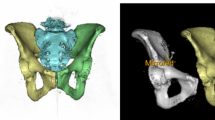Abstract
Severe pelvic fractures often prove difficult for surgeons as they require patient-specific surgical treatment plans and customized equipment. Developing virtual patient-specific 3D pelvis models would ease the surgical planning process and enable development of custom fixation plates. This paper aims to examine pelvic symmetry to conclude whether the contralateral side may be used as a reference model for the fractured side of the pelvis. Fourteen subjects with intact pelvises were involved in this study. CT scans of the pelvises were converted to 3D models and the right sides of the pelvises were reflected and aligned with the left sides. A deviation analysis was then performed for each set of models and results showed that the average root mean square (RMS) of values was 1.14 ± 0.26 mm and the average percentage of points below a deviation threshold of ± 2 mm was 91.9 ± 5.55%. The deviation color maps (DCMs) showed that the largest deviations were on the non-articular surfaces. The volume and surface area of each model were also examined and showed no significant differences between left and right sides. These results indicate that the pelvis displays bilateral symmetry and this concept can be used to develop fully intact patient-specific 3D pelvis models for fracture reconstruction using the unfractured contralateral side.

Graphical Abstract







Similar content being viewed by others
Abbreviations
- CAD:
-
Computer-aided design
- 3D:
-
Three dimensional
- CT:
-
Computed topography
- RMS:
-
Root mean square
- DCM:
-
Deviation color map
References
Dreizen S, Snodgrasse RM, Webb Peploe H et al (1957) Bilateral symmetry of skeletal maturation in the human hand and wrist. AMA J Dis Child 93:122–127. https://doi.org/10.1001/archpedi.1957.02060040124004
Grammer K, Thornhill R (1994) Human (Homo sapiens) facial attractiveness and sexual selection: the role of symmetry and averageness. J Comp Psychol 108:233–242. https://doi.org/10.1037/0735-7036.108.3.233
Adams GJ, Simoni DM, Bordelon CB et al (2002) Bilateral symmetry of human carotid artery atherosclerosis. Stroke 33:2575–2580. https://doi.org/10.1161/01.STR.0000035736.30488.7A
Tümer N, Arbabi V, Gielis WP, de Jong PA, Weinans H, Tuijthof GJM, Zadpoor AA (2019) Three-dimensional analysis of shape variations and symmetry of the fibula, tibia, calcaneus and talus. J Anat 234:132–144. https://doi.org/10.1111/joa.12900
Vignesh U, Mehrotra D, Dichen, et al (2017) Three dimensional reconstruction of late post traumatic orbital wall defects by customized implants using CAD-CAM, 3D stereolithographic models: A case report. J Oral Biol Craniofacial Res 7:212–218. https://doi.org/10.1016/j.jobcr.2017.09.004
Ismail HD, Lubis MF, Djaja YP (2016) The Outcome of Complex Pelvic Fracture after Internal Fixation Surgery. Malaysian Orthop J 10:16–21. https://doi.org/10.5704/MOJ.1603.004
Taller S, Lukás R, Srám J, Krivohlávek M (2005) Urgent management of the complex pelvic fractures. Rozhl Chir 84:83–87
(UK) NCGC (2016) Fractures (Complex): Assessment and management. National Institute for Health and Care Excellence (UK)
Comstock CP, Van Der Meulen MCH, Goodman SB (1996) Biomechanical comparison of posterior internal fixation techniques for unstable pelvic fractures. J Orthop Trauma 10:517–522. https://doi.org/10.1097/00005131-199611000-00001
Stocks GW, Gabel GT, Noble PC, Hanson GW, Tullos HS (1991) Anterior and posterior internal fixation of vertical shear fractures of the pelvis. J Orthop Res 9:237–245. https://doi.org/10.1002/jor.1100090212
Nieminen J, Pakarinen TK, Laitinen M (2013) Orthopaedic reconstruction of complex pelvic bone defects. evaluation of various treatment methods. Scand J Surg 102:36–41. https://doi.org/10.1177/145749691310200108
Wang D, Wang Y, Wu S et al (2017) Customized a Ti6Al4V bone plate for complex pelvic fracture by selective laser melting. Materials (Basel) 10. https://doi.org/10.3390/ma10010035
Mehra M, Somohano T, Choi M (2016) Mandibular fibular graft reconstruction with CAD/CAM technology: a clinical report and literature review. J Prosthet Dent 115:123–128. https://doi.org/10.1016/j.prosdent.2015.05.012
Dell’Aversana Orabona G, Abbate V, Maglitto F et al (2018) Low-cost, self-made CAD/CAM-guiding system for mandibular reconstruction. Surg Oncol 27:200–207. https://doi.org/10.1016/j.suronc.2018.03.007
Islam K, Dobbe A, Komeili A, Duke K, el-Rich M, Dhillon S, Adeeb S, Jomha NM (2014) Symmetry analysis of talus bone. Bone Joint Res 3:139–145. https://doi.org/10.1302/2046-3758.35.2000264
Jansen J, Dubois L, Schreurs R et al (2018) Should virtual mirroring be used in the preoperative planning of an orbital reconstruction? J Oral Maxillofac Surg 76:380–387. https://doi.org/10.1016/j.joms.2017.09.018
Boulay C, Tardieu C, Bénaim C et al (2006) Three-dimensional study of pelvic asymmetry on anatomical specimens and its clinical perspectives. J Anat 208:21–33. https://doi.org/10.1111/j.1469-7580.2006.00513.x
Osterhoff G, Petersik A, Sprengel K, Pape HC (2019) Symmetry matching of the medial acetabular surface—a quantitative analysis in view of patient-specific implants. J Orthop Trauma 33:e79–e83. https://doi.org/10.1097/BOT.0000000000001373
Zhao H, Herman B, Adeeb S et al (2013) Investigation of the geometries of the coronoid process and the fibular allograft as a potential surgical replacement. Clin Biomech 28:626–634. https://doi.org/10.1016/j.clinbiomech.2013.05.004
Komeili A, Westover LM, Parent EC et al (2014) Surface topography asymmetry maps categorizing external deformity in scoliosis. Spine J 14:973-983.e2. https://doi.org/10.1016/j.spinee.2013.09.032
Moody ML, Koeneman J, Hettinger E, Karpman RR (1992) The effects of fibular and talar displacement on joint contact areas about the ankle. Orthop Rev 21:741–744
Acknowledgments
The authors would like to thank Irina Ilic for her assistance in the pelvis digitization process.
Funding
This work was funded by the Natural Sciences and Engineering Research Council of Canada (NSERC).
Author information
Authors and Affiliations
Corresponding author
Ethics declarations
In order to use the clinical data, a waiver of consent was received and approval was obtained from the Health Research Ethics Board at the University of Alberta.
Conflict of interest
The authors declare that they have no conflict of interest.
Additional information
Publisher’s note
Springer Nature remains neutral with regard to jurisdictional claims in published maps and institutional affiliations.
Rights and permissions
About this article
Cite this article
Ead, M.S., Duke, K.K., Jaremko, J.L. et al. Investigation of pelvic symmetry using CAD software. Med Biol Eng Comput 58, 75–82 (2020). https://doi.org/10.1007/s11517-019-02068-w
Received:
Accepted:
Published:
Issue Date:
DOI: https://doi.org/10.1007/s11517-019-02068-w




